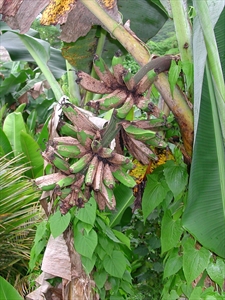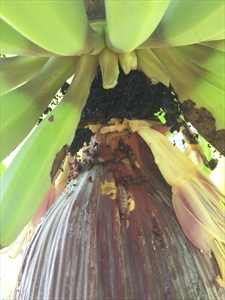Banana scab moth
Pacific Pests, Pathogens and Weeds - Online edition
Pacific Pests, Pathogens & Weeds
Banana scab moth (017)
Nacoleia octasema (previously, Lamprosema octasema)
Asia and Oceania. It is recorded from American Samoa, Australia, Fiji, Federated States of Micronesia, New Caledonia, Samoa, Solomon Islands, Tonga, Vanuatu, and Wallis and Futuna.
Banana, plantain, Heliconia and Pandanus.
The caterpillars feed on the skin of the young fruit, while hiding in protected areas between the fingers and the fruit stalk. Sometimes, they eat through the skin and feed on the banana pulp. Damaged areas form a black scab (Photo 1).
Eggs are laid in the early evening on or near to an emerging banana bunch. The eggs are flat, oval-shaped and about 1.3 mm across. They are laid singly or in clusters of up to 30 and look like overlapping fish scales.
The caterpillars hatch after about 4 days and move to the young fruit under the tightly closed bracts (the leaves around the young bunches) to feed. As the bracts and hands lift from the bunch stalk, the caterpillar moves to the next closed hand. When newly hatched, the caterpillars are about 1.5 mm long and clear yellow; when fully-grown, they are up to 50 mm long, and vary from pinkish-grey to very dark brown (Photos 2-4).
After feeding for about 2 weeks, the caterpillars are ready to pupate. They spin a thin silken cocoon, adding some rubbish, which helps to hide them. Inside the cocoons, the caterpillars turn into brown pupae. The cocoons are either on the banana plant or nearby in the leaf litter.
After 8-10 days, the adult moths emerge; they are a pale straw colour, with a wingspan of about 30 mm (Photos 5&6). They have a row of small black dots around the edges of the wings. Moths hide during the day; they mate and lay eggs in the early evening.
The scab moth caterpillar is considered a serious pest in Samoa and elsewhere in the southwest Pacific. It is also very damaging in the commercial plantations in Australia, and routine treatments are applied rather than relying on estimates of moth populations as they are difficult to predict. Any damage to the fruit can result in downgrading and/or rejection of the fruit and economic loss.
Look at the young developing fruit. Look for feeding damage - black scabs on the skin, or caterpillar droppings. Banana bunches should be inspected when bracts have begun to lift, but before they start to fall. Pay special attention to the undersides of the fingers - those closest to the bunch stalk.
NATURAL ENEMIES
The caterpillars are attacked by several kinds of tiny wasps that are hard to see without a microscope. Spiders and other general predators also attack them. These natural enemies, however, are not enough to reduce damage to acceptable levels.
CULTURAL CONTROL
- Inspect the banana crop daily for emerging flower stalks - by the time flower stalks have bent horizontally, shortly after emergence, some fruit damage may already have occurred.
- Partly or completely remove the flower bracts, then spray the fruit with water, or dust them with ashes. This will reduce the damage.
CHEMICAL CONTROL
-
Use biopesticides. These are biological insecticides that cause insect diseases. Use the following:
-
Spinosad (Success), Beauvaria bassiana, Metarhizium anisopliae or Bt - Bacillus thuringiensis (Dipel).
-
But note, biopesticides are expensive, but they do not kill the natural enemies, as do synthetic products.
-
-
In Australia, chlorpyrifos, bifenthrin, acephate and bendiocarb are the recommended chemicals for bunch injection.
-
Inject when the bunch is still upright in the throat of the plant. Inject 20 to 40 ml of dilute insecticide about a third of the way down from the top of the spear. Injections above or below this will either damage the fruit or not be effective.
Spraying with chemicals (rather than injecting them) often does not work against this pest, because the insect is so well hidden. Therefore, some commercial growers lift or remove the flower bracts and dust or spray insecticide onto the fruits after the flower has bent over. This method can stop some damage but not all.
____________________
When using a pesticide, always wear protective clothing and follow the instructions on the product label, such as dosage, timing of application, and pre-harvest interval. Recommendations will vary with the crop and system of cultivation. Expert advice on the most appropriate pesticides to use should always be sought from local agricultural authorities.
AUTHORS Helen Tsatsia & Grahame Jackson
Information from DAF (2017) Banana scab moth. Business Queensland. Queensland Government. (https://www.daf.qld.gov.au/business-priorities/agriculture/plants/fruit-vegetable/insect-pests/banana-scab-moth); and CABI (2019) Nacoleia octasema (banana scab moth). Crop Protection Compendium. (https://www.cabi.org/cpc/datasheet/26691); and (including Photos 2&4) Schmaedick M (2005) Banana scab moth. American Samoa Community College, Community & Natural Resources, Cooperative Research & Extension. (https://www.ctahr.hawaii.edu/adap/ASCC_LandGrant/Dr_Brooks/BrochureNo6.pdf); and from Henderson RC, Crosby TK (2012) Banana Scab Moth (Nacoleia octasema): PaDIL - http://www.padil.gov.au. Photo 1 Nacoleia octasema caterpillar damaging banana "fingers" (Graham Teakle). Photos 3&6 Mani Mua SPC Sigatoka Research Station, Fiji. Photo 5 CSIRO website of Common Names. (http://www.ces.csiro.au/aicn/name_c/a_228.htm).
Produced with support from the Australian Centre for International Agricultural Research under project PC/2010/090: Strengtheni4g integrated crop management research in the Pacific Islands in support of sustainable intensification of high-value crop production, implemented by the University of Queensland and the Secretariat of the Pacific Community.









